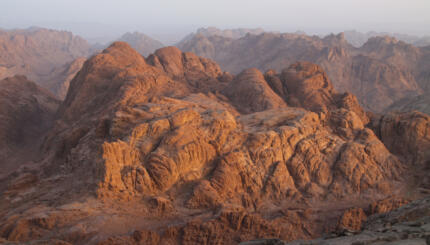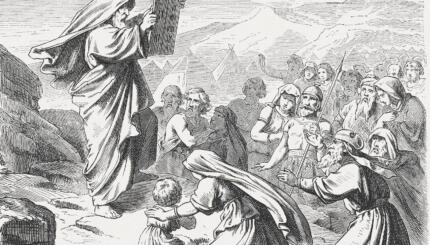Commentary on Parashat Devarim, Deuteronomy 1:1 - 3:22
Giants are a mainstay of mythology and folklore, evoking both fear and fascination. Simultaneously inhuman and superhuman, their massive bodies seem to contravene the laws of nature and pose an existential threat to human culture. As the literary scholar Mikhail Bakhtin put it, the giant grotesquely “outgrows its own self, transgressing its own body,” symbolically threatening all that is “closed, smooth, and impenetrable” in human society—be it “organized religion, statecraft, or any other forms of social hierarchy.”
As such, giants often function in narratives as prehistoric foes, monsters from a primordial era who need to be defeated in order to pave the way for stable civilization. In classical mythology, in colonial rhetoric, even in modern pop culture, violent, volatile giants belong to a threatening, but ultimately primitive, bygone past. The heroic “giant killers,” in contrast, possess a superior human status, and their victory augurs progress, prosperity, and peace.
At first glance, the Israelites’ defeat of Og, king of Bashan, in Parashat Devarim neatly fits this pattern. Og is described in the Torah as a scion of the Refaim, a branch of the gigantic Anakite people who had long inhabited Canaan. As Moses recounts in the opening chapters of Deuteronomy, God’s command that the Israelites conquer and settle Canaan was predicated on their having the courage to defeat this nation of giants.
Nearly 40 years earlier, Moses recalls, an earlier generation of Israelites had listened with horror to the spies, who reported the presence of “a people stronger and taller than we, large cities with walls sky-high, even Anakites.” Deuteronomy 1:28 These Anakites were so large, the spies had warned, that “we looked like grasshoppers to ourselves, and so we must have looked to them.” Numbers 13:33 The land of Canaan was bounteous, the spies confirmed, but this bounty was itself threatening—a single cluster of grapes required two people to carry it. How could the Israelites possibly hope to defeat those who could casually grasp those grapes between their fingers?
Og, whose kingdom would eventually comprise the northeastern boundary of Israelite settlement in Canaan, was the first of the giants to be defeated, and Moses recounts how the Israelites “dealt him such a blow that no survivor was left.” Deuteronomy 3:3 Every inhabitant of Og’s kingdom was destroyed, as were all their fortified and unwalled towns. Rabbinic sources flesh out these details, depicting a cataclysmic scene. In the Talmud, Og is described as so enormous that his ankle is 30 cubits off the ground and he possesses an arsenal comprising a massive mountain he lifts from the ground and tries to hurl at his opponents. God counters by bringing the same mountain down upon Og’s head, crushing him.
Just as God had assured Moses he had nothing to fear from Og, Moses in turn assures his successor Joshua that he need not fear the giants. “Be strong and resolute,” Moses tells him, for “the Lord your God will battle for you.” And indeed, Og’s defeat foreshadows the Israelite’s eventual success in eliminating the remaining branches of the Anakites. By ridding the land of giants, Moses and Joshua can usher in the very human society that, according to Bakhtin, giants symbolically threaten—one complete with organized religion, statecraft, and social hierarchy.
But surprisingly — and subversively — several passages in Parashat Devarim belie the notion that the giants represent only the forces of primordial chaos. At several points, Moses implies the opposite—that the giants are not a threat to, but rather the embodiment of, stable human culture. In several verses, Moses goes out of his way to chart the historical pedigree of the Anakites, and provides a detailed catalogue of the names by which various nations referred to them: Refaim and Anakim, but also Eimim, Nefilim, and Zamzumim. This seemingly extraneous chronological data anchors the giants in the land — not in the mists of history, but in the relatively recent past, almost as though he were narrating biblical history from their perspective.
A similar impression emerges from a fascinating verse inserted into Moses speech: “[Og’s] bedstead, an iron bedstead, is now in Rabbah of the Ammonites; it is nine cubits long and four cubits wide, by the standard cubit.” Deuteronomy 3:11 Rather than locating giants in a distant realm, Moses is telling us that verifiable proof of Og’s gargantuan size can be found in nearby Rabbah. Moreover, we learn that Og presided over a culture that not only had the wherewithal to memorialize him by preserving his bedstead, but that it could build that bedstead out of iron, an advanced technological capability during the Bronze Age.
Finally, while the majority of rabbinic interpretations of these verses highlight the primitive nature of the Anakim, a tantalizing few take a different interpretive tack. In commenting on the name Zamzumim, several midrashic collections explain that it was derived etymologically from the word zimzum, which means intentionality or planning. This was because “they accomplished whatever they planned” (Pesikta Zutarta), an explanation that later interpreters recast as “they were men of great wisdom and cleverness” (Bekhor Shor). Drawing on this tradition, the 16th-century commentator Eliezer Ashkenazi posited that the seven names for giants that appear in the Torah correspond to the seven branches of the sciences: thus, the Refaim invented medicine, the Anakim developed astronomy, and so on.
Developing Bakhtin’s insight, the literary critic Walter Stephen suggested that “far from symbolizing a mature culture, the folkloric Giant represents the perils that had to be overcome in order for that culture to be born and thrive.” Jarringly, these voices within the biblical and rabbinic corpus seem to be arguing the opposite—that Og and the Anakim are precisely the mature culture, one that the upstart Israelites threaten and ultimately disrupt. Moses and the Israelites were not clearing the land of primordial monsters to make way for stable human civilization; on the contrary, they were destabilizing an existing, historically rooted society. Rather than agents of “mature culture,” we might say the Israelites are bearers of counterculture—disrupting political precedent, questioning cultural assumptions, unsettling ostensibly immutable social mores. The giants, in this reading, are not primitive foes to be vanquished, but a competing, compelling culture to be resisted.
To be sure, this interpretation veers from the literal meaning of the biblical verses—verses which have given rise to disturbing questions about military ethics, indigeneity, and ethnic cleansing. But it also arguably accords better with nearly two millennia of Jewish historical reality, in which Jews have more often occupied marginal, beleaguered, ostensibly “degenerate” positions than they have positions of hegemonic dominance. As Moses and Joshua might have intuitively understood, to succeed as a “giant killer”—someone who is willing to go against the grain and to voice unpopular truths—requires courage and the willingness to spend time in the metaphorical wilderness. But the consolation is that doing so is, at its core, God’s work—that one can “be strong and resolute” in the knowledge that “the Lord your God will battle for you.”



